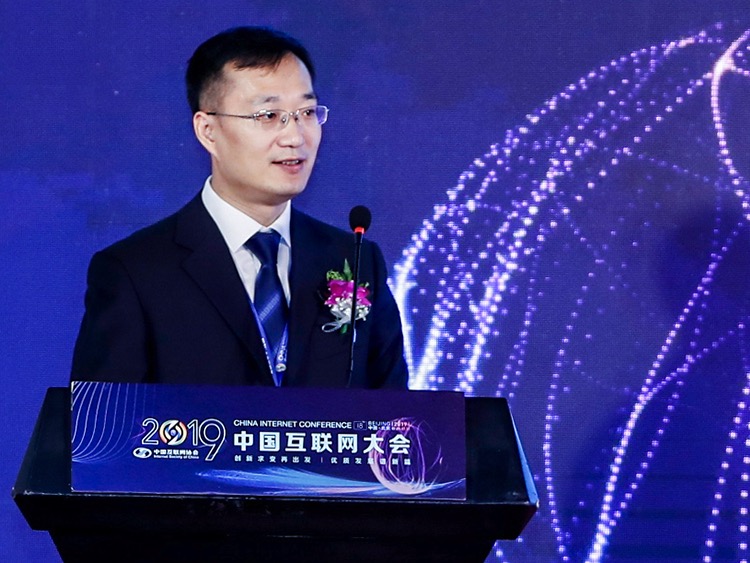
From July 9th to 11th in 2019, the 18th China Internet Conference was held at the Beijing Convention Center. The theme of the conference was “Innovation, Change, and Departure – A New Chapter of Quality Development”. The industry’s oldest Internet conference in ceremonies welcomed its adult year with the 50th anniversary of the birth of the Internet and China’s full-featured access to the Internet for 25 years.
At the meeting, the Chinese Academy of Engineering academician and the chairman of the China Internet Association, Wu Hequan , said that 5G was born at the right time, its arrival will give birth to an unimaginable format of industries, and the Internet is at an important juncture, and the digital infrastructure re-opened by 5G technology will be rebuilt. Chairman of Hyperchain Information Technology Co., Ltd., parallel blockchain inventor and founder Shi Xingguo, also gave a speech on the digital infrastructure of the 5G era at the senior conference of the Internet Conference, and explained how the parallel blockchain can support the 5G era as an vital part of the infrastructure.
Shi Xingguo first pointed that the infrastructure is nonlinear, fissile and ecological, and small change can cause subversion of the industry, which is evident from the end of Motorola and Nokia in 4G era。 Compared to 4G, the connection capacity of 5G has increased by 2,000 times, but this single change can lead to a new economy that is far beyond the original Internet total, such as 4K HD video, Internet of Things, smart city, industrial Internet, etc., followed by exponential growth.
In such a digital economy era, it is simply not enough to form a digital infrastructure with only 5G. As the Secretary General of the World Development Institute of the Development Research Center of the State Council, Zheng Yannong, said, the next generation of Internet infrastructure must be integrated with ABCD technology in order to truly “re-start”: AI artificial intelligence, Blockchain blockchain, Cloud Computing cloud computing, Big Data big data. Shi Xingguo also analyzed that the massive data generated by 5G transmission faces the problem of how to distinguish the authenticity and utility of data when calculating through artificial intelligence. Only by using the blockchain data traceability and confirmation can be performed in the data. Decentralized trust is formed: 5G provides hardware infrastructure, artificial intelligence and edge computing form the computing infrastructure, and blockchain is a necessary data infrastructure to form data governance rules.
We can see that the new digital economic infrastructure starting with 5G requires a highly integrated blockchain. This coincides with the view of the Chairman of the Hong Kong Stock Exchange, Li Xiaojia. The 5G era will bring together a large amount of data “heavy assets”, and its value will be much larger than the current consumer Internet. In this case, the rights and transactions of data must be completed by blockchain technology.
However, Shi Xingguo admits that the traditional blockchain is not enough to become the next generation of data-based value interconnection infrastructure. The existing blockchains can be broadly divided into a coalition chain that requires a license and a public chain that does not require a license. Due to the limited access of its nodes, the consortium chain is destined to be a public facility for everyone. It can only be used within the organization. Like Facebook, BFT is used to run Libra, which is bound to be limited in development. The public chain is mostly serial. Single-chain, low-performance, limited scalability, isolated and closed, support business is limited to digital currency and finance, and far from the infrastructure that can support the future data economy. To achieve the infrastructure level of the public chain, it is necessary to solve the problems of scalability, cross-chain interconnection and energy stability.
From the improvement of the traditional blockchain in the past, there has not been any solution that can effectively solve the above fatal problems. Past improvement measures are limited to the serial data structure of the blockchain, and the scalability and interconnectivity are extremely limited; or the data structure characteristics of the blockchain are destroyed, and the scalability is improved, but the block is seriously damaged. The decentralization and security of the chain cannot make the blockchain an infrastructure that can be infinitely expanded, barrier-free, highly stable and then low-energy, carrying data value exchange and the next-generation digital economy.
Based on the above situation, Shi Xingguo and the Hyperchain team began to study the parallel blockchain direction four years ago, and found that after upgrading the blockchain from the original one-dimensional serial structure to the two-dimensional parallel structure, many “classic” problem is solved by the natural problem: the scalability of the serial chain can be solved by the dynamic fragmentation of the sub-chain in the parallel chain and the infinite increase of the number of sub-chains. The serial chain can be closed in a parallel environment. Breakthrough through a natural cross-chain interconnection , the serial chain has serious business limitations, and in the parallel chain, it can accommodate multiple services and assets to ensure ecological diversity.
Parallel chains can allow any node to join in like Bitcoin, or extend the scope of business like Ethereum, which joins smart contracts. It breaks through the parallel chain of performance and cross-chain interconnections and can efficiently support “bitcoins” and “Ethereum” and so on, thus truly become the infrastructure supporting the digital economy of the 5G era. After four years of research layout, Shi Xingguo and the hyper chain team have obtained the first batch of parallel blockchain related patents, but Shi Xingguo said : “The door for infrastructure should be open to everyone.” The ultra-blockchain parallel blockchain technology is now completely open source, and has launched Paralism, an application ecosystem platform based on its parallel blockchain, which can be used by industry, enterprises and individual users to deploy applications, develop business and build ecology.
